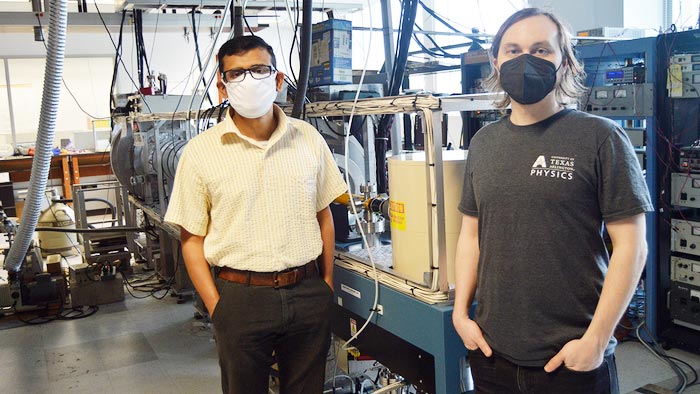Advances in spectroscopy

Varghese Chirayath, left, and Alex Fairchild
Credit: UT Arlington
UTA physicists find new way to measure properties of a material’s surface layer.
Physicists at The University of Texas at Arlington have developed a new technique that can measure the properties of the topmost atomic layer of materials without including information from the underlying layers.
Researchers from the Positron Lab in the UTA Department of Physics utilized a process called auger-mediated positron sticking (AMPS) to develop a novel spectroscopic tool to measure the electronic structure of the surface of materials selectively.
A new article, “Photoemission spectroscopy using virtual photons emitted by positron sticking: A complementary probe for top-layer surface electronic structures,” published in the journal Physical Review Letters (PRL), details the new technique. In addition, the online magazine Physics published a Viewpoint article on the publication, titled “Spectroscopy That Doesn’t Scratch the Surface,” which explains why the paper is important to the field. Viewpoint articles are commissioned by PRL editors for papers they believe will draw broad interest.
Alex Fairchild, postdoctoral scholar in the Positron Lab, is the study’s lead author. Co-authors include Varghese Chirayath, assistant professor of research; Randall Gladen, postdoctoral researcher; Ali Koymen, professor of physics; and Alex Weiss, professor and chair of the UTA Department of Physics. Bernardo Barbiellini, professor of physics at LUT University in Finland, also contributed to the project.
The AMPS process, in which positrons (antimatter of electrons) stick directly to surfaces followed by electron emission, was first observed and described by Saurabh Mukherjee, a graduate student, along with Weiss and other colleagues, in 2010 at UTA. Those results were published in a paper in PRL.
“Alex (Fairchild) and Varghese figured out how to use this phenomenon that we discovered in 2010 to measure the top layer and get information about the electronic structure and the behavior of the electrons in the top layer,” Weiss said. “That will determine a material’s many properties, including conductivity, and can have important implications for building devices.”
Fairchild said the AMPS process is unique because it uses virtual photons to measure the topmost atomic layer.
“This is different from typical techniques like photoemission spectroscopy, where a photon penetrates multiple layers into the bulk of a material and therefore contains the combined information of the surface and subsurface layers,” Fairchild said.
“Our AMPS results showed how virtual photons emitted following positron-sticking interact preferably with electrons that extend further into the vacuum than with electrons that were more localized to the atomic site,” Chirayath said. “Our results are thus essential to understand how positrons interact with surface electrons and are extremely important to understand other similarly surface-selective, positron-based techniques.”
Weiss noted that the UTA Positron Lab is currently the only place this technique could have been developed, due to the capabilities of its positron beam.
“At present, UTA probably has the only lab in the world that has a positron beam that can get down to the low energies needed to observe this phenomenon,” Weiss said.
The study was supported by funding from the Welch Foundation and the National Science Foundation.
Written by Greg Pederson, College of Science
Journal: Physical Review Letters
Subject of Research: Cells
Article Title: “Photoemission spectroscopy using virtual photons emitted by positron sticking: A complementary probe for top-layer surface electronic structures”
Article Publication Date: 29-Aug-2022
Media Contact
Linsey Retcofsky
University of Texas at Arlington
linsey.retcofsky@uta.edu
Office: 817-272-2710
All latest news from the category: Physics and Astronomy
This area deals with the fundamental laws and building blocks of nature and how they interact, the properties and the behavior of matter, and research into space and time and their structures.
innovations-report provides in-depth reports and articles on subjects such as astrophysics, laser technologies, nuclear, quantum, particle and solid-state physics, nanotechnologies, planetary research and findings (Mars, Venus) and developments related to the Hubble Telescope.
Newest articles

A universal framework for spatial biology
SpatialData is a freely accessible tool to unify and integrate data from different omics technologies accounting for spatial information, which can provide holistic insights into health and disease. Biological processes…

How complex biological processes arise
A $20 million grant from the U.S. National Science Foundation (NSF) will support the establishment and operation of the National Synthesis Center for Emergence in the Molecular and Cellular Sciences (NCEMS) at…

Airborne single-photon lidar system achieves high-resolution 3D imaging
Compact, low-power system opens doors for photon-efficient drone and satellite-based environmental monitoring and mapping. Researchers have developed a compact and lightweight single-photon airborne lidar system that can acquire high-resolution 3D…





















